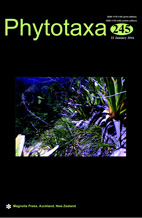Abstract
Pitcairnia azouryi is a species of Bromeliaceae restricted to Atlantic Forest inselbergs of southeastern Brazil. Since the species was first described, populations of P. azouryi have been observed from three locations in the states of Rio de Janeiro and Espírito Santo. Here we report four new populations discovered after extensive fieldwork during a period of three years on 21 inselbergs in the states of Espírito Santo and Rio de Janeiro, Brazil. With the discovery of these four new populations from the inselbergs Pedra Lisa, Pedra do Jacu, Pedra Três Irmãs e Pedra Parada Cristal (all located in the State of Espírito Santo), the number of locations where P. azouryi is known to occur has increased to seven. The analysis of these new samples allowed the evaluation of within species morphological variation, compared to the protologue description of plant height and leaf dimensions. We classify Pitcairnia azouryi as endangered (EN). This classification is based on the species’ extension of occurrence (1,470 km2), area of occupancy (ca. 53 km2), number of known populations (7), and the fact that none of its occurrence sites are within a protected conservation areas.

